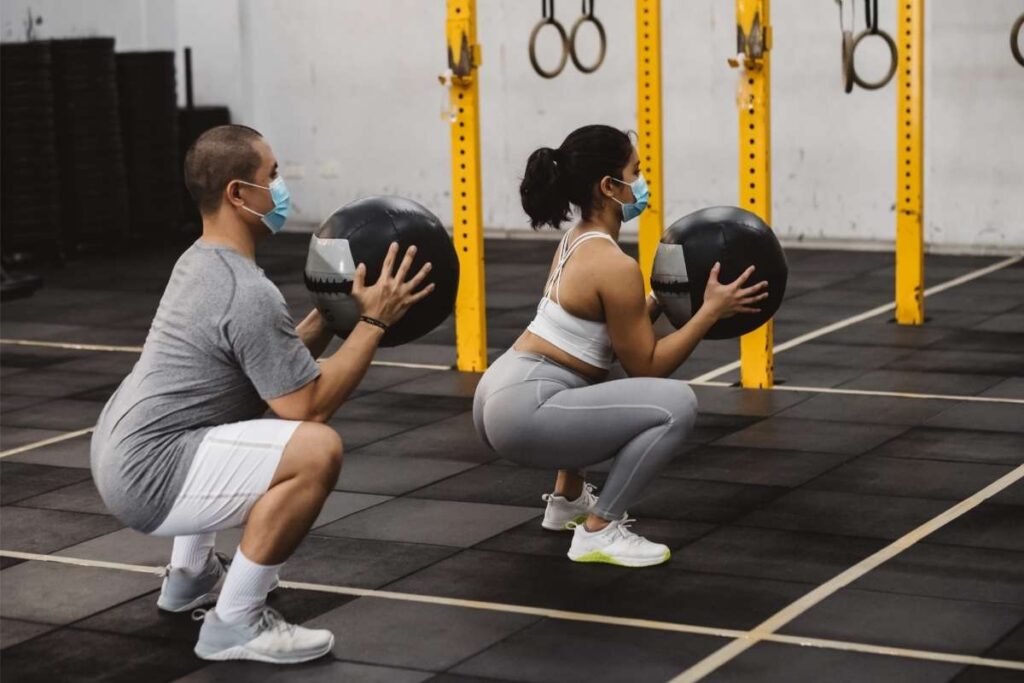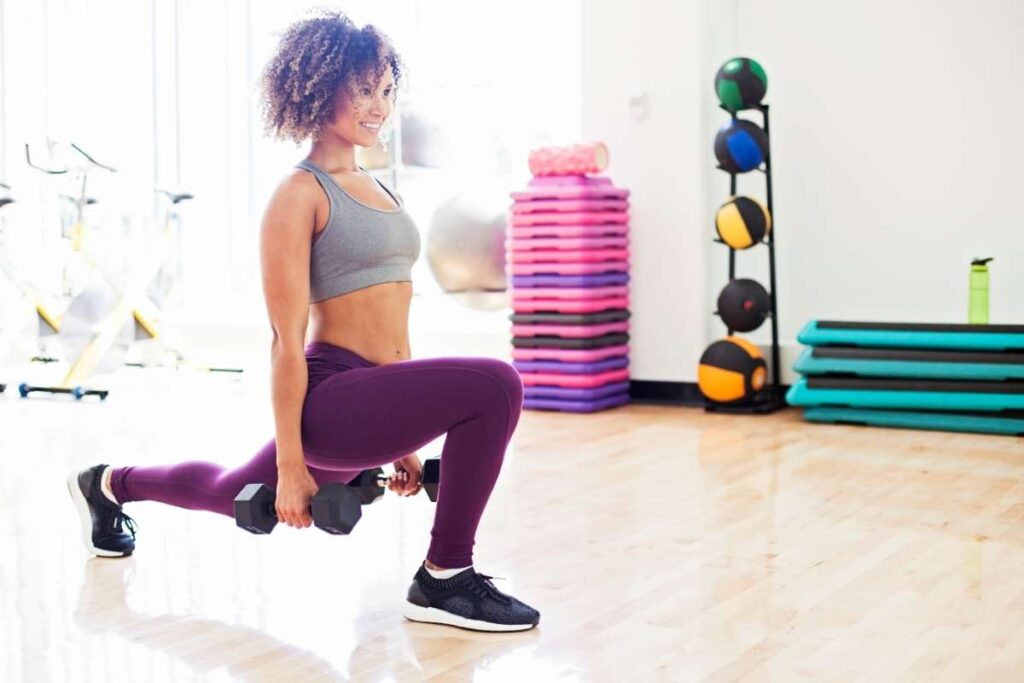What's inside
If you follow the fitness community on Instagram, YouTube or TikTok, you’ve no doubt come across videos of the Knees Over Toes Guy.
His name is Ben Patrick, and some of his viral content shows him performing impressive feats.
These include things like dunking a basketball before going straight into the splits or squatting down on a staircase and touching his knees to the step below.
Some of these moves make people with knee pain cringe just to watch, and I don’t blame them. This can easily give the first impression that a knees over toes program can be harmful.
So, let’s take a closer look. This article will explain the biomechanics and philosophy behind the knees over toes exercises, programs, and videos.
We’ll bust the myths around training with the knees over the toes and give you all the details on the Knees Over Toes Guy and his programs.
What is knees over toes?

The concept of knees over toes (KOT) is simply the message that it’s okay for the knees to travel past the toes during exercises like squats and lunges.
It’s been a common misconception that increasing pressure in the knee joint at certain angles is inherently bad or dangerous for the knee.
The content from Knees Over Toes Guy aims to educate viewers on how to strengthen their knees (and other joints) from the ground up, using a greater range of motion than previously recommended.
What is the Knees Over Toes Program?

There are several knees over toes programs, starting from complete beginner level. From there, you progress through to strength and building athletic ability.
The first program recommended to start with is called “Knee Ability ZERO,” and requires – you guessed it – zero equipment to perform.
This program has lower body strength and flexibility exercises to do on Monday, Wednesday, and Friday, as well as optional upper body and mobility work on Tuesday and Thursday.
Once the ZERO program is completed, members are able to move on to the Dense Strength Program.
This program uses short but effective workouts to focus on building strength in key areas that will reduce pain, help prevent injury and build athletic potential in the major joints and muscles.
The third main knees over toes program is the Strength Standards – a four-day per week program that builds the trainee toward achieving certain targets in athletic strength.
There is also a Women of ATG (Athletic Truth Group – more on that shortly) program which uses many similar exercises, but with a focus on comfort for female trainees.
Who is the Knees Over Toes Program for?
Related: 7 Day Gym Workout Plan For Beginners

The knees over toes training philosophy originated from Ben Patrick’s own journey through pain, injury, and surgeries on his knees.
Since then, the KOT programs have been designed to be suitable for people of any age or ability.
There are regressions and progressions for each exercise, which means everyone from Ben’s pregnant wife to his older-aged parents are training in this style.
When any individual is starting with a knees over toes program, the key is that they start at a level that is comfortable, pain-free, and just challenging enough to allow gradual progression.
What happens when the knees go over toes?

The main concern in the past with the knees traveling over the toes was that there was thought to be detrimental forces placed through the knee joint.
However, the old evidence has since been disproved, with newer studies showing that full range of motion at the knee may actually be beneficial for the tissues involved.
Of course, several factors must be considered when looking at exercises in which the knees travel past the toes.
These include limb length, flexibility, past injury, and of course, technique.
Since the knees travel over the toes in many daily activities, from squatting down to jumping or running, it’s a very functional ability to train.
In summary, knees over toes during lower body exercises is not the detriment it was once thought to be and may even help those with pain or weakness in the lower limb.
Who created the Knees Over Toes Program?
The most well-known knees over toes programs were created by Ben Patrick, founder of ATG – Athletic Truth Group.
In addition to the core ATG programs, like Knee Ability Zero, Dense Strength, and Standards, there is a range of other programs included in the membership.
These include things like an advanced version of Zero, ATG for longevity, ATG for speed, and even an evolving program based on exactly how Ben himself trains.
Who is the Knees Over Toes Guy?
Ben Patrick, also known online as Knees Over Toes Guy, is a fitness influencer and coach for thousands of online clients.
Patrick had a long journey of reversing himself out of knee pain after multiple knee injuries and surgeries and began teaching his training methods through social media.
Now, the official Knees Over Toes Instagram has over 1.6 million followers, with many subscribers through other channels as well.
Knees Over Toes Exercise Guide
One of the things that make the KOT training style so unique is some of the exercises, which many people haven’t seen anywhere else.
This section will show examples of a few of these moves, as well as the unique ATG spin Ben puts on more common exercises to make them more effective.
Tibialis Raise
This unique exercise aims to strengthen the tibialis anterior, or front of the shin.
This muscle is often neglected in training but is key for athletic ability and ankle and knee health.
Pigeon Stretch
Also known as the 90/90 stretch, this move has many benefits for mobility in the lower back, hips, and thighs.
Couch Stretch
This stretch is an excellent counter to sitting all day, lengthening the deep hip flexors and quadriceps.
ATG Split Squat
Related: Do Squats Work Abs
One of the core exercises of knees over toes training, the ATG split squat is where you’ll start to build your KOT ability.
With many progressions for any ability level, this exercise will be key for many trainees looking to bulletproof their knees.
Sled Pull
Reverse sled walking is a staple exercise in ATG programs, and a great way to warm up the anterior knee and quads.
Full ROM Dip
The KOT style of dip involves working toward a full range of motion in the shoulder.
For those with shoulder pain or previous injury, professional coaching or advice should be sought before attempting this exercise.
Pancake Stretch
This is a great stretch for lengthening the hamstrings, adductors, and mobilizing the lower back.
Knees Over Toes Workout
The following workout uses the above exercises as an example of what a knees over toes session can entail.
This is a full-body workout using some of the commonly seen exercises used in KOT training.
Many of the actual sessions in KOT programs break the workouts up into upper and lower body sessions, so this workout is a combination.
There is a warm-up with a reverse sled (or walking backward up an incline for those without a sled), followed by several KOT exercises, and finally some effective stretches to loosen up.
| Exercise | Sets x Reps | Rest |
| Sled Pull/Reverse Uphill | 5 min | – |
| Full ROM DB Overhead Press | 4×10 | 2-3 min |
| Tibialis Raise | 3×20 | 30 sec |
| Full ROM Pull-Ups | 4×10 | 3-5 min |
| KOT Split Squat | 5×5 each side | 1-2 min |
| Full ROM Dips | 4×12 | 2-3 min |
| Hanging Leg Raise | 3×10 | 1-2 min |
| Pigeon Stretch | 2 min each side | – |
| Couch Stretch | 2 min each side | – |
| Butterfly Stretch | 2 min each side | – |
You can perform this program up to three times per week, for example on Monday, Wednesday, and Friday.
How much does the Knees Over Toes Program cost?
The Knees Over Toes Programs are offered as a subscription service, with a price of $49.50 per month.
Members are given access to all of the different ATG programs, as well as coaching on their form from each workout.
In some cases, there’s an introductory offer of $30.00 for the first month. There is no lock-in contract for the ATG membership.
Is knees over toes legit?
As mentioned, the knees over toes training philosophy is based on recent research that shows several benefits of allowing the knee to naturally travel past the toes.
One study found that when knee movement is restricted, it can lead to unwanted load traveling through the hips and lower back.
More research displayed a significant improvement in knee performance and strength in post-op patients who had been training using exercises used in KOT programs.
Where to Start With the Knees Over Toes Program

While members of ATG training have access to all of the programs at any time, there is a typical progression recommended for new trainees.
Members usually start with the Zero program, which has progressions for complete beginners or those returning from an injury.
From there, you can move on to the Dense Strength program, which will build on the foundation achieved in Zero.
There is also the Standards program for those looking to further build their athletic ability.
There is no set time for each program, you simply progress from one to the next once you’ve achieved the recommended performance metrics in your current program.
Knees Over Toes Reviews: What are people saying?
The ATG Online Coaching Platform website has many stories from people who have had great results from Knees Over Toes Training.
Many people find KOT training after suffering from injury or pain in the joints and tissues of the lower body.
These include people with shin splints, Achilles tendon injury, knee surgeries, and even lower back issues.
The KOT programs seem to be successful in helping people reverse knee pain, bulletproof their joints, and build strength and mobility for both athletic and everyday endeavors.
Final Thoughts
So, what do you think about our guide to the knees over toes philosophy? We hope this article helped inform you of why this training method is gaining popularity on social media.
It might be difficult to re-train yourself to allow the knees to pass the toes, but it could be worth it. As always, starting slow and listening to your body is key.
Let us know if you’ve tried any of the knees over toes exercises or programs – and if they’ve helped – in the comments.
If you know anyone suffering from knee pain, or just wanting a unique program to bulletproof their joints and build their athletic ability, share this article with them as well.
Frequently Asked Questions
What are the Knees Over Toes workouts?
The knees over toes workouts can change depending on the program you are doing.
Most ATG workouts consist of stretches for the lower body joints and muscles, as well as exercises to strengthen the joints through a full range of motion.
Knees over toes workouts involve unique exercises, including tibialis raises, Nordic curls, ATG split squats, and others not typically seen in the average gym program.
One of the unique types of knees over toes workouts are the Dense Strength Program sessions, which involve performing 10 sets of selected exercises in 10 minutes.
How long is the Knees Over Toes program?
KOT programs are designed to be done for as long as needed to progress beyond pain and improve athletic ability.
For example, you may spend 12 weeks on the ZERO program before progressing to Dense Strength or Standards for the next few months.
Because the programs are a subscription service with video feedback on your technique, you can use them on an ongoing basis to progress to (and beyond) your goals.
Why should knees go over toes?
Contrary to prior belief, the increased demand on the tissues of the knees can in fact be beneficial for strengthening and lengthening the tissues.
The degree to which the knees travel over the toes can vary greatly between individuals, and is not ‘bad’ or ‘good’ in general, but depends on the case.
The main idea is that the commonly used coaching cue “don’t let the knees go past the toes” is no longer justified by the scientific literature.
In short, if it feels comfortable and is biomechanically sound for your body, the knees going over the toes is perfectly safe and beneficial when done with good technique.
Is Knees Over Toes Safe?
As mentioned above, this depends on the individual and the exercise they are performing.
Not only do we need to consider the angle of the knee, but the direction of movement as well.
For example, a forward lunge in which the knees go over the toes will produce different forces in the knee than a reverse lunge.
Training safely depends on being well informed, and probably consulting with an exercise professional who can coach your form.
This is especially applicable for those suffering from pain or injury to any joints or tissues of the lower limb.

